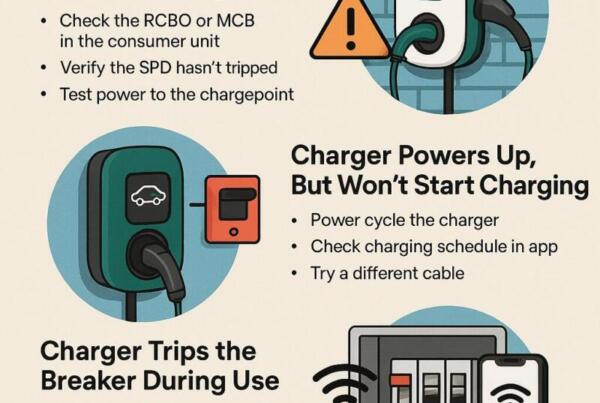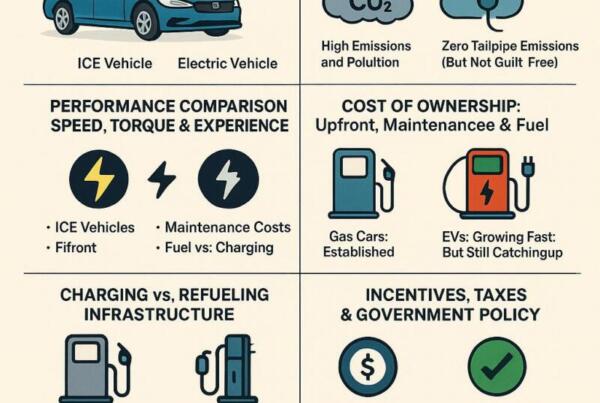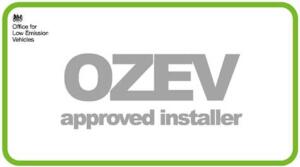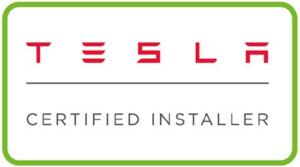Charging points are an efficient way of charging your electric car at home
If you have a 100% electric car (BEV) or a plug-in hybrid (PHEV), charging points allow you to charge your car’s battery.
There are various places you can do this including:
- Home (assuming you have off street parking)
- Work
- Motorway service stations
- Petrol stations
- Certain streets and car parks
- ‘Destinations’ including hotels, sports centres, shopping centres, supermarkets, etc.
Charging points are also known as charging stations, car chargers, charge points, EV chargers, wall boxes, superchargers and the list goes on and on!
If you get a new electric car the dealer may well throw in a home charging point for free. In this case an installation company such as EcoGreen Electrical will come round and install it in your home at no cost.
If a charging point is not bundled with your new EV then you can choose your own model and installer.
Should I get a charging point? Follow our 6-step guide:
If you want the full story about how to choose the right wall box charger take a look at the following 6-step guide:
- Rule existing infrastructure in or out: Can you survive on a 3-pin socket?
- Understand the technology: Find out how electric car charging points work
- See if it makes sense for you: Read our 10 reasons to get a charging point at home
- Work out the type of charging point you need: We help you cut through the jargon
- Compare different models: Explore manufacturer websites
- Find a local installer: Get in touch with a reputable local chargepoint installer such a EcoGreen Electrical

1. The Limitations of a 3-pin Socket
If you don’t have a dedicated charging point you can simply plug your EV into a normal 3-pin 13A home socket. This is often referred to as ‘trickle charging’.
3-pin Socket

The standard 3-pin socket can only supply a small amount (a trickle) of electricity to your car. This means your EV’s battery charges quite slowly.
For example, using a 3-pin socket it can take anywhere from 7 hours to more than a day to fully charge an electric car depending on how big your battery is.
The other drawback to a 3-pin socket is that there is no safety mechanism to keep the plug in the socket securely. If you trip on the cable, you could easily pull the plug out. That’s not safe.
Note: although a 3-pin socket is rated at 13A, it will probably only deliver about 10 amps when charging your EV. This makes it a 2.3 kWcharge point (10 amps x 230 volts = 2.3 kW).
The Alternative: 16A to 32A Chargepoints

Given the limitations of a 3-pin socket a dedicated 16A or 32A home charging point for your electric car really makes sense.
A proper EV charging point will charge your battery more quickly and more safely than a 3-pin plug.
A 16A chargepoint will charge your battery at 3 to 3.6 kW whereas a 32A charger will deliver about 7 kW of power. See our page on “Where can I charge my EV?” for further details on charging speeds and locations.
There is also a £350 grant towards the cost of the installation, assuming you meet the OZEV criteria (OZEV used to be OLEV – don’t ask). See our OZEV Grant page for further details.
Commando Socket
Sitting between a normal household socket and a dedicated 13A or 32A EV charger is the commando socket.

The Ohme charging cable brings smart charging to any socket, including commando sockets
Commando plugs and sockets were originally designed for industrial settings. It’s a no-nonsense, colour-coded, weather-proof system.
Why would you use a commando socket? They are cheaper than a dedicated EV chargepoint and any electrician can install one. They also offer better safety than a 3-pin plug.
You can also make a commando socket ‘smart’ by installing the Ohme EV charging cable. The Ohme has clever electronics built into the cable itself. It can, for example, automatically charge your car only when electricity is at its cheapest.
2. How EV Charging Points Work
We are all used to charging our mobile phones at the end of the day. You lay it on the desk, plug it into the charger, and leave it over night. In the morning the battery’s at 100%. Bingo!
Your electric car is no different. You park your car, plug it into its charging point, and leave it over night. The next morning the car battery is at 100%. The equivalent of a full tank. No need to nip off to the petrol station.
The Charging Point

An EV charging point is basically a glorified socket.
The difference though, is that a car charging point can draw more electricity to charge the car more quickly. They are also safer, and come with a securing mechanism to stop the plug from coming loose accidentally.
Charging points are installed on a suitable wall. For example in your garage or on an external wall near your driveway.
EV On-board Charging Interface
It’s possible that your car might stop you from charging at the fastest rate the charging point can offer.
This is because each EV has electronics inside that take the AC power from the charging point and convert it into DC.
Imagine your electric car has a 3.3 kW on-board charger/interface. If you plug it into a home charging point rated at 7 kW, the car will only be able to receive electricity at 3.3 kW.
If you already have an EV check the maximum power rating it can take for 3 kW and 7 kW charging points.
Most modern EVs have high on-board charger ratings. For example, the Hyundai Kona Electric can charge at up to 11 kW on AC power.
Smart Chargepoints

Zappi smart EV charger
Many chargepoints are now officially ‘smart’.
Since July 2019, the government will only pay out the £350 installation grant for EV chargers it designates as smart. Smart basically means the charger can be communicated with and monitored remotely.
An example of a smart charger is Myenergi’s Zappi. If you have solar panels a Zappi can be programmed to charge your EV only when the sun is shining and solar electricity is being generated.
In this way you can guarantee 100% renewable energy charges your electric car. No fossil fuels in sight.
Smart chargers also come with apps for your phone. Most apps allow you to start and stop charging remotely, program automatic charging times, see the charging rate, record historic charging data, and so on.
Vehicle to Grid
Vehicle to Grid (V2G) charging points are in their infancy, but will be big news going forward.
These devices not only allow electricity to flow from your house into your car but also the other way: out of your car into your house and even further out into the National Grid.
Why would you want that? Because you can use that enormous battery sitting on your drive to power your home that’s why. You can also sell electricity stored in your car’s battery. Companies will pay good money to access your battery and take electricity out of it when electricity demand around the country is high.
At the moment the only 100% EV in the UK to offer this bi-directional electricity flow is the Nissan Leaf. You also need a special charging point such as one developed by OVO Energy.
3. Ten Reasons to Get a Charging Point
This is going to be a tough section to write…
If you have off-street parking then a dedicated home charging point is a no-brainer. You can charge your car’s battery, whether in a BEV or a PHEV, much more quickly and safely than with a standard 3-pin socket.
As we have “10 reasons to get…” for electric cars, solar panels, and battery storage, we have no choice but to give this a go:
- You can charge your electric car more quickly at home.
- A professionally installed charging point improves electrical safety.
- There is a grant from OZEV which will cover a lot of the cost of the installation.
- Many chargepoints are smart and can, for example, divert solar electricity to charge your car.
- They can also be set to charge automatically when electricity is cheapest, or when it’s greenest (e.g. grid electricity from wind turbines).
- The car dealer may give you a charging point for free any way.
- It will look nice on your wall.
- Your neighbours will be impressed.
- If you’re a man it’s yet another gizmo.
- If you’re a woman it’s a gizmo that is actually useful.
Hopefully you are now convinced. Time to look at the different types.

4. What Type of Charger do I Need?
You know that feeling when you stare at 50 washing machines in the store and have no idea which one to choose? It’s the same with EV charging points.
3 kW, 3.6 kW or 7 kW?
There are lots of manufacturers and even more models. They all look different, but fortunately they are fairly similar inside. Generally, there are two versions:
- 3 kW charging point with a 16A trip switch
- 7 kW charging point with a 32A trip switch
Go for the 7 kW option as your car’s battery will charge twice as quickly.
You won’t be charged for more electricity using a 7 kW charger. The same amount of electricity will go into your EV just roughly twice as fast as with a 3 kW chargepoint.
Some chargers offer both 3 kW and 7 kW charging in the same unit.
Even if your car is limited to say 3.3 kW charging a 7 kW charger gives you more options in the future.
Universal / Untethered Charging Points

An untethered charging point
In your car, probably in the boot or ‘frunk’ (front boot), you will find one or more cables. One of these cables can connect your car to a dedicated wall-mounted chargepoint. The other cable if you have one connects the car to a normal house-hold 3-pin socket.
You get the charge point cable out of the car. Plug one end into the car itself and the other into the charging point on the wall. Hey presto! Electricity will flow from your house, through the charging point, down the cable and into your car.
Charge points that accept the cable that comes with your car are known as ‘universal’. They may also be advertised as ‘tethered’ or ‘untethered’.
A universal charging point is handy if you change car to a different make in the future. You should always be able to plug any electric car into a universal charge point assuming future standards don’t change too dramatically.
Tethered Charging Points

A tethered charging point.
Alternatively you can get a chargepoint with a cable wrapped around it. This is called a ‘tethered’ charging point. Uncoil the cable, plug it into your car, and the charging will begin.
Tethered charging points come with a specific plug shape that matches your car’s socket. This will generally be a Type 2 plug, possibly a Type 1 (see below).
Most modern EVs comes with a Type 2 socket for home charging such as these models:- Tesla Model 3, Kia e-Niro, Renault Zoe, Nissan Leaf, Jaguar I-Pace, Mercedes EQC, Audi e-tron, etc.
In theory, if you change car in the future, the plug on your tethered cable might not fit into the new car’s socket. In practice, you can get adapters to change the shape of the tethered plug to match the car’s socket.
A big advantage of a tethered cable is that you can simply park your car, grab the cable and plug it in! With a universal charging point, you have to get your cable out of the car, plug one end into the car and then plug the other end into the charging point. It’s a bit more hassle, especially when it’s raining.
Charging Point Connector Types
Your electric car will either have one or two different types of socket to plug into, for example:
- Type 1
- Type 2
- CHAdeMO
- CCS
If you do go on to buy a home charger, make sure both you and the installer / manufacturer know exactly which sockets your EV has.
5. Compare Charging Point Models
The following manufacturers sell EV charging points in the UK:
- Myenergi / Zappi
- EO Charging
- Viridian EV
- Ohme
- Circontrol
- POD Point
- BP Chargemaster
- NewMotion
- Ensto
- Andersen
- JuiceBox
- EVBox
- Alfen
- Keba
- Schneider Electric
- Rolec EV
- WallBox
This is not an exhaustive list and new manufacturers are appearing all the time.
The models on offer range from simple to highly intelligent. The more advanced models offer more functionality and are more future-proof than others.
Please note: from July 2019 onwards all home charge points where the customer obtains the OZEV grant (old name: OLEV grant) must use ‘smart technology’. Smart chargepoints can be accessed remotely and various functions turned on or off via a signal. Make sure the manufacturer can prove the model you want is smart. And check the make and model on the GOV website as they have a list of OZEV approved chargepoints.
6. Find a Charging Point Installer
Now that you have looked at all the various models of EV charge points, it’s time to get in touch with local installers such as EcoGreen Electrical for quotations.
Installing a home charging point is relatively simple. Any qualified electrician can do it.
However, to get the £350 OZEV grant, the electrician’s company must be approved by OZEV.
In addition, the electrician’s company must be accredited by the manufacturer for the particular charging point model you are interested in.
To find your ideal chargepoint, give EcoGreen Electrical a call today and we can guide you effortlessly through the whole process, from installation to recieving your grant.











